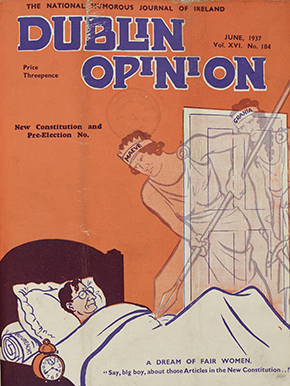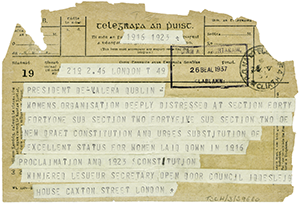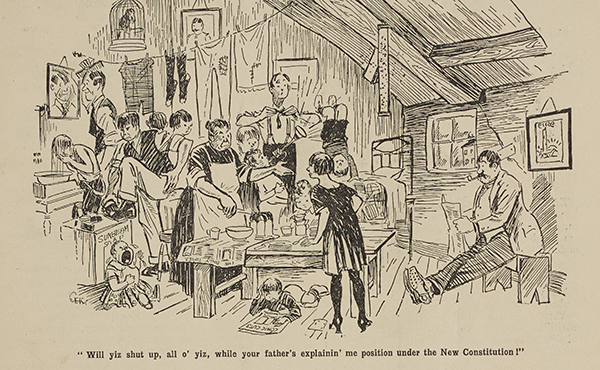‘A mixture of flattery and insult’
Published in 20th Century Social Perspectives, 20th-century / Contemporary History, Features, Issue 3 (May/June 2018), Volume 26Women’s opposition to the 1937 Constitution.
By Joyce Padbury
The women’s campaign against the 1937 Constitution was a short and, in the end, unsuccessful intervention in a major political debate, though it did initially achieve amendments to some provisions of the draft document. The campaign is worth remembering as a lively articulation of feminist opinion that surprised the political establishment by its vigour, its persistence and its critical dexterity.

Above: De Valera is haunted by a ‘dream of fair women’ (Maeve and Grainne)—front cover of Dublin Opinion, June 1937. On the suggestion of Hanna Sheehy Skeffington it was reproduced for circulation by ‘no’ advocates. (NLI)
Leading figures
Professor Mary Hayden, as president of both the NUWGA and the National Council of Women, was a significant figure in the campaign; others included Hanna Sheehy Skeffington, her sister Mary Kettle, Mary Macken, Agnes O’Farrelly, Dorothy Macardle, Kathleen Lynn and Louie Bennett. The campaign included speeches, published articles, letters to the newspapers, lobbying of government and opposition Dáil members, and a meeting with de Valera followed by a memorandum presented to him by ‘members of a university in which perfect equality of rights and opportunities has been enjoyed by women both in theory and practice since its foundation in 1908’.
Before the draft constitution received final approval from the Dáil, the possibility of discrimination on grounds of sex was excluded from the provisions on citizenship and voting rights (Article 16), de Valera agreeing to restore the phrase ‘without distinction of sex’ from the 1922 Constitution, though he considered it ‘altogether unnecessary’. Not successful were efforts to secure amendments to Articles 40 and 41, with their references to ‘differences of capacity, physical and moral, and of social function’, to woman’s ‘life within the home’ and to the ‘duties in the home’ of mothers.
Article 45.4.2 originally read:
‘The State shall endeavour to ensure that the inadequate strength of women and the tender age of children shall not be abused, and that women and children shall not be forced by economic necessity to enter avocations unsuited to their sex, age or strength.’
This was amended by deletion of the phrase ‘the inadequate strength of women’ to read instead ‘the strength and health of workers, men and women’. The term ‘women and children’ became ‘citizens’, thus including men in the provision. Even with these amendments, feminists foresaw possible discrimination in public life and in employment as a consequence of the three disputed articles, which were particularly objectionable to middle-class women.
Public meeting in the Mansion House
The constitution was passed by the Dáil on 14 June 1937, by which date the NUWGA was planning its campaign against it as a whole. Posters, newspaper advertisements and a large public meeting were added to the letters and articles appearing since the start of the campaign. The public meeting took place on 21 June in the Mansion House, with Prof. Mary Macken in the chair. The attendance was variously reported as 1,200 or 1,500. As Gertrude Gaffney in the Irish Independent wrote:
‘It was wonderful. They kept coming in droves, old women, middle-aged women, young women, working women, professional women, girls from the Sweep and the Civil Service, girls out of shops and offices … They filled every seat in the Round Room, they thronged the balconies, they sat on the steps of the stage … and some had to stand all the time.’
Speakers included Mary Hayden, Mary Kettle, Eileen Davitt, Kathleen Lynn and Hanna Sheehy Skeffington, and letters of support were read from prominent republican women, Kathleen Clarke and Kate O’Callaghan.
Mary Hayden was applauded for her statement that they did not stand for any particular government—they stood for women. A general election was to be held on the same date as the referendum, but the women’s campaign, insisting throughout on its non-political stance, advised women to vote in the election ‘as they chose’ while voting against the constitution. In the referendum, 57% of those who voted favoured the constitution, with a high rate of abstention. The failure of the women’s campaign is attributed principally to its limited middle-class appeal, mainly Dublin-based, and to the irrelevance of the abstract concept of equality for the daily lives of the average woman throughout the country.
‘The convolutions of the feminine mind’

Above: A telegram critical of the new constitution from the London-based Open Door Council to Éamon de Valera. Founded in 1926, the Council was particularly opposed to restrictions on female economic freedom, which tended to be justified under the guise of ‘protecting’ women from unsuitable (and well-paid) work. This is one of several documents featured in Trinity College’s on-line exhibition, ‘Violence, Ridicule and Silence’, https://www.tcd.ie/library/exhibitions/suffrage/ (see pp 6–7). (NAI)
But the campaigners were not to be deflected. Women like Mary Hayden and Hanna Sheehy Skeffington, veterans of earlier achievements of equality in university education and in suffrage, were particularly exercised about damage to the role of women signalled by the contentious provisions—Hayden, for example, expounding on the more favourable status for women in early and medieval Ireland. Mary Macken, in a letter to the newspapers, defended Catholic women critics from the charge of disagreement with papal encyclicals, on which some of the constitutional provisions were believed to have been based, and she analysed the separation of church and state in the context of the constitution.
Leaflets and advertisements addressed to women voters were published, and a cartoon on the cover of Dublin Opinion featuring de Valera with Queen Maeve and Grainne Mhaol O’Malley was reproduced for circulation on the suggestion of Hanna Sheehy Skeffington. Several other cartoons appeared in Dublin Opinion, poking gentle fun at both women and men and at the constitutional proposals.

Above: ‘… me position under the New Constitution’—Dublin Opinion, June 1937. (NLI)
Although the campaign to reject the constitution did not succeed, it had achieved amendments that secured the equal citizenship and voting rights of women. The failure with regard to women’s role in society and in employment, where feminists saw women being excluded as they had been in the past, was not queried by the majority of women. The paternalism of the conservative state and the belief in separate spheres for men and women were to persist for several decades.
Joyce Padbury has published articles on various aspects of the life of Mary Hayden.
Read More:
The context
FURTHER READING
- M. Cullen, ‘Women, emancipation and politics, 1860–1984’, New History of Ireland, Vol. VII (Oxford, 2003), 826–91.
- B. Farrell (ed.), De Valera’s constitution and ours (Dublin, 1988).
- J. Padbury, ‘Mary Hayden—feminist’, Studies 98 (2009), 145–58.
















